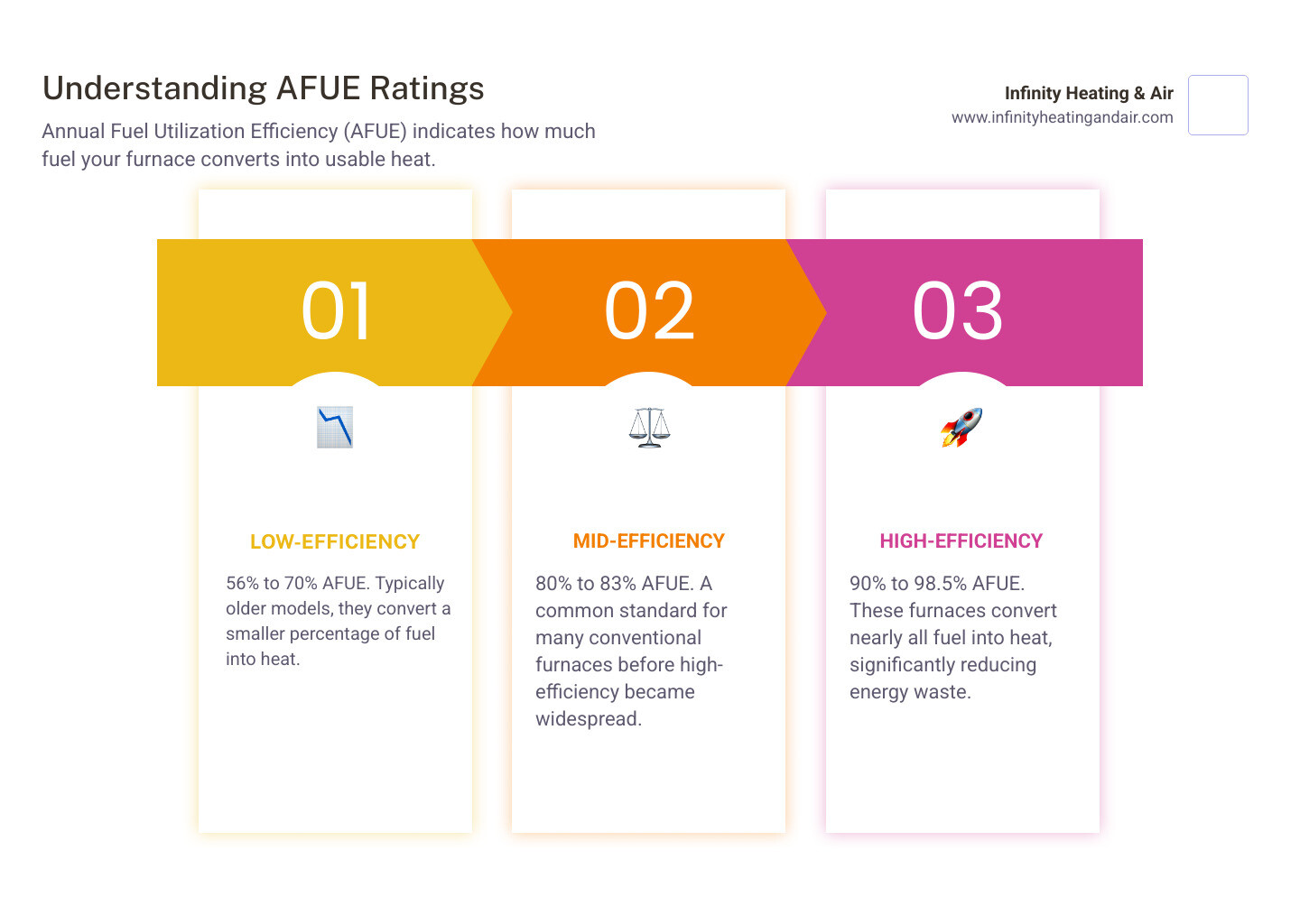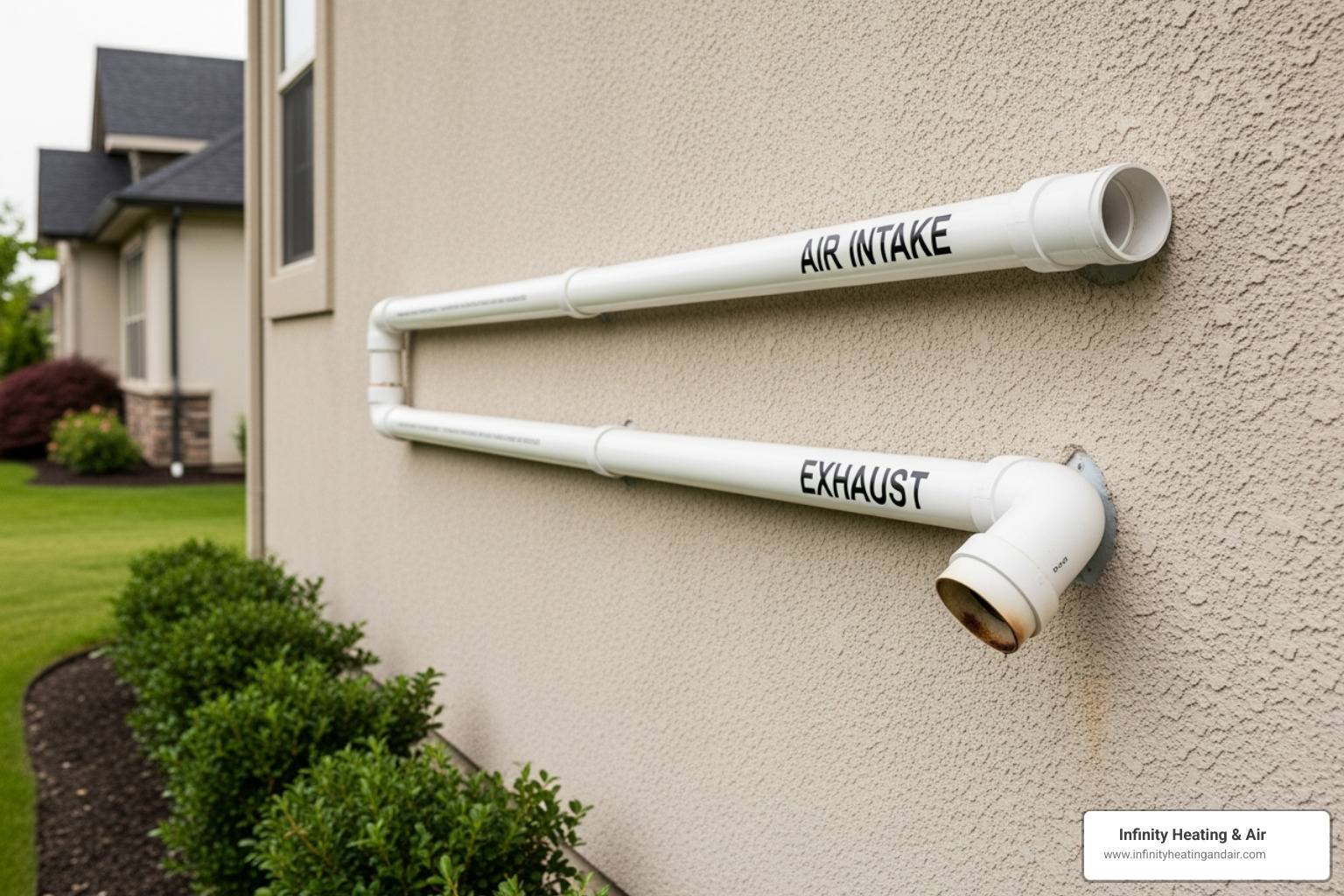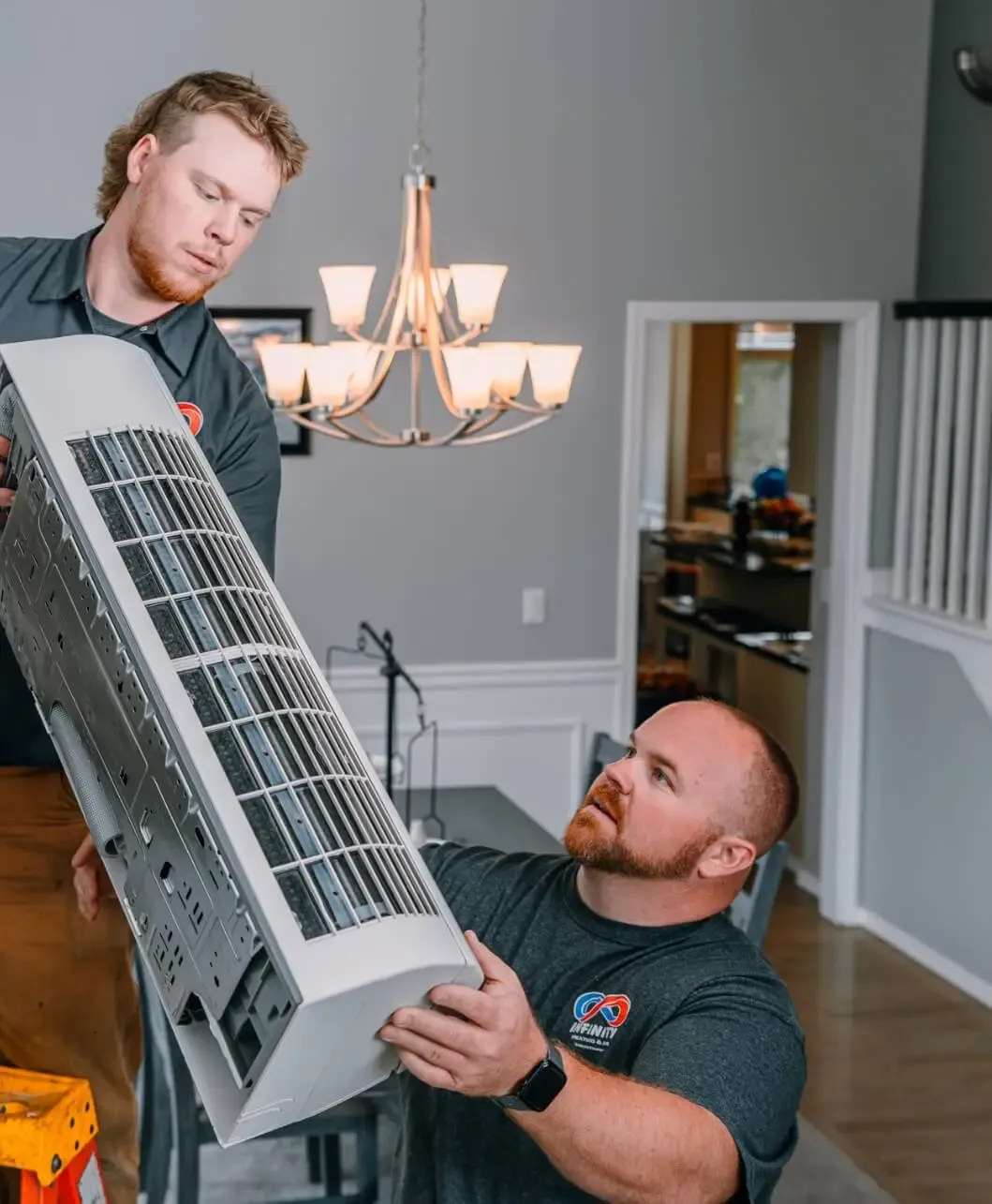
Unpacking High Efficiency Furnaces: Your Guide to Smarter Heating
High-Efficiency Furnaces: Save money & improve comfort with Infinity Heating & Air. Discover key benefits in our 2025 guide.
.webp)

Your Guide to Smarter Home Heating
If you’re looking to update your home’s heating, a high efficiency furnace is a key player in keeping your home warm and your energy bills down.
So, what makes a furnace ‘high-efficiency’? It all comes down to its AFUE rating.
AFUE stands for Annual Fuel Utilization Efficiency. This number tells you how much of the fuel your furnace turns into actual heat for your home.
Here’s the breakdown:
- Low-efficiency furnaces (often older models): 56% to 70% AFUE
- Mid-efficiency furnaces: 80% to 83% AFUE
- High-efficiency furnaces: 90% to 98.5% AFUE
Heating your home is a big deal, especially here in Northwest Washington. You want a cozy, comfortable space, but you also don’t want to break the bank on utility bills.
That’s where energy efficiency comes in. Modern furnaces have come a long way. They’re designed to deliver more heat using less fuel.
This guide will walk you through everything you need to know about these advanced heating systems. We’ll cover how they work, their benefits, and what to consider when choosing one for your home.

What Defines a High-Efficiency Furnace?
When we talk about a high efficiency furnace, we’re primarily referring to its Annual Fuel Utilization Efficiency (AFUE) rating. This crucial metric, often found on the yellow EnergyGuide label required by the Federal Trade Commission, indicates how effectively the furnace converts fuel into usable heat for your home.
For a furnace to be considered high-efficiency according to the U.S. Department of Energy standards, it must have an AFUE rating of 90% or higher. This means that at least 90% of the energy in the fuel becomes heat for your home, with only a small percentage escaping as exhaust. To put it simply, for every dollar you spend on fuel, 90 cents or more go directly to heating your living space, making it a very smart investment for your utility bill.
Compared to standard furnaces, which typically operate around 80% AFUE, a high-efficiency model uses an additional 15% of the heat produced during the combustion process to warm your home. This significant difference in fuel conversion directly translates into lower energy consumption and considerable savings on your heating expenses, which can account for roughly 45% of your utility bill!
Understanding AFUE Ratings
AFUE is more than just a number; it’s a direct measure of a furnace’s energy performance over a typical heating season. It’s a snapshot of how efficiently your furnace is working for you.
Let’s break down the different efficiency levels:
- Low-efficiency heating systems: These are often older, traditional furnaces, possibly with natural draft and continuous pilot lights. They typically have AFUE ratings ranging from 56% to 70%. Imagine nearly half of your fuel dollar literally going up the chimney!
- Mid-efficiency heating systems: These units generally range from 80% to 83% AFUE. They’re an improvement over older models but still fall short of truly maximizing your fuel use.
- High-efficiency heating systems: As mentioned, these furnaces boast impressive AFUE ratings of 90% to 98.5%. Modern conventional heating systems can achieve efficiencies as high as 98.5%, converting nearly all the fuel to useful heat for your home. This range is where you see the biggest impact on energy savings and environmental footprint.
Reading the label on a furnace is straightforward. The yellow EnergyGuide label will clearly display the AFUE rating, allowing you to easily compare models and understand their potential energy consumption.
How a High Efficiency Furnace Achieves Its Rating
So, how do these furnaces work their magic to achieve such impressive efficiency levels? It’s all about clever engineering and making the most of every bit of heat.

Unlike standard furnaces that have a single heat exchanger, high efficiency furnaces typically use a secondary heat exchanger. This is the secret sauce! After the primary heat exchanger warms the air, the exhaust gases, which still contain a significant amount of heat, are routed through this second exchanger. Here, even more heat is extracted from these gases.
This process is known as condensing technology because it cools the exhaust gases to the point where the water vapor within them condenses into a liquid. This condensation releases latent heat, which is then captured and added to your home’s heating, instead of being wasted up the flue.
Beyond the heat exchangers, high efficiency furnaces incorporate several other advanced features:
- Sealed combustion: They draw combustion air from outside your home, preventing heated indoor air from being used and then vented away. This also improves safety.
- Advanced motors: Many high-efficiency units use variable-speed blower motors or ECM (Electronically Commutated Motor) motors. These motors are incredibly efficient, adjusting their speed precisely to meet your home’s heating needs, which saves energy and ensures consistent airflow.
- Smart controls: Electronic controls and modulating gas valves allow the furnace to precisely adjust its heat output, rather than just being “on” or “off.” This means it can run at lower capacities for longer periods, providing more consistent temperatures and greater comfort.
By combining these technologies, a high efficiency furnace squeezes every last bit of usable heat from the fuel, dramatically reducing waste and maximizing your comfort.
The Core Technologies of Modern Furnaces
This section explains the key components that differentiate high-efficiency models from their standard counterparts, showcasing the ingenuity behind their superior performance.
Secondary Heat Exchanger and Condensing Process
At the heart of a high efficiency furnace’s remarkable performance lies its innovative use of a secondary heat exchanger and the condensing process.
In a traditional furnace, fuel is burned in a primary heat exchanger, and the hot combustion gases then exit through a flue, taking a considerable amount of heat with them. It’s like letting a lot of warmth escape through a leaky window!
A high efficiency furnace takes a different approach. After the primary heat exchanger has done its job, the still-warm exhaust gases are directed into a second, typically stainless steel, heat exchanger. Here, these gases are cooled further, extracting additional heat that would otherwise be lost.
This cooling process is so effective that the water vapor present in the exhaust gases condenses into a liquid. This phase change releases a significant amount of “latent heat,” which the furnace captures and uses to preheat the air circulating through your home. This is why these units are often called “condensing furnaces.”
The condensate produced is slightly acidic (a weak carbonic acid, formed from water and carbon dioxide), which is why the secondary heat exchanger must be made of corrosion-resistant materials like stainless steel. This condensate is then safely drained away through a dedicated condensate drain line, typically to a floor drain or a small pump that sends it outdoors. This ingenious method ensures that nearly all the heat generated by the fuel is put to good use, leaving very little to escape as waste.
Sealed Combustion for Safety and Efficiency
One of the most significant advancements in high efficiency furnace design is sealed combustion. This technology isn’t just about efficiency; it’s also a major leap forward in home safety and indoor air quality.

Unlike older furnaces that draw combustion air from inside your home, a sealed combustion system brings outside air directly into the furnace through a dedicated intake pipe. This means the furnace doesn’t compete with your family for precious indoor air, preventing issues like negative pressure and potential back-drafting of combustion gases (including dangerous carbon monoxide) into your living space. It’s a closed system, ensuring that combustion byproducts are safely exhausted directly outdoors through a separate vent pipe.
This feature is particularly beneficial for modern, tightly sealed homes where indoor air quality and ventilation are paramount. By not relying on indoor air for combustion, a sealed combustion furnace maintains consistent indoor air pressure and prevents heat loss that would occur if warm indoor air were constantly being pulled into the furnace and vented outside. It’s a win-win for both your energy bill and your peace of mind.
Variable-Speed Blowers and Staged Heating
Beyond AFUE, the “comfort factor” of a high efficiency furnace is significantly influenced by its blower and heating stages.
Traditional single-stage furnaces are like an “on/off” switch. They operate at full capacity whenever heat is called for, regardless of how much heat is actually needed. This can lead to temperature swings, hot and cold spots, and a noisy blast of air.
High efficiency furnaces often feature more sophisticated heating stages and variable-speed blower motors:
- Two-stage heating: These furnaces have two heat output levels – usually a high stage for very cold days and a lower stage for milder temperatures. This allows the furnace to run longer at a lower, more efficient setting, providing more consistent warmth and reducing temperature fluctuations.
- Modulating furnaces: Taking it a step further, modulating furnaces can continuously adjust their heat output from about 40% to 100% capacity. They’re like a dimmer switch for your heat, precisely matching the heat demand of your home.
Both two-stage and modulating furnaces are typically paired with a variable-speed blower motor. This motor can adjust its speed to precisely control the airflow. Instead of blasting air at full speed, it can deliver a gentle flow of warm air for longer periods. This leads to:
- Even temperature distribution: Say goodbye to cold spots! The consistent airflow gently mixes the air, creating uniform temperatures throughout your home.
- Reduced noise levels: Lower blower speeds mean significantly quieter operation, contributing to a more peaceful home environment.
- Energy conservation: By operating at lower, more efficient speeds for longer durations, these blowers use less electricity, further contributing to your energy savings.
These advanced features ensure that your home receives not just efficient heating, but also truly customized and comfortable warmth, as you can learn More on home heating systems.
Key Benefits and Considerations for Homeowners
Upgrading your furnace is a significant decision. Here are the primary advantages and factors to keep in mind, ensuring you make the best choice for your home and family.
The Main Advantages of a High Efficiency Furnace
Investing in a high efficiency furnace brings a wealth of benefits that extend beyond just heating your home. We’ve seen the positive impact these systems have on homes across Graham WA, Western Washington, and throughout Washington.
Here’s a list of the key advantages:
- Lower utility bills: This is often the biggest motivator! With AFUE ratings of 90% or higher, these furnaces convert more fuel into heat, significantly reducing your monthly energy consumption. Upgrading your furnace from 56% to 90% efficiency in an average cold-climate house can save 1.5 tons of carbon dioxide emissions each year if you heat with natural gas, or 2.5 tons if you heat with oil. This translates directly into tangible savings on your heating expenses.
- Improved comfort: Features like variable-speed blowers and multi-stage heating provide more consistent temperatures throughout your home, eliminating those annoying cold spots and ensuring even heat distribution. You’ll experience “endless comfort” as we like to call it!
- Quieter operation: Thanks to variable-speed motors and advanced designs, high efficiency furnaces run much more quietly than older, single-stage models. No more loud blasts of air interrupting your peace and quiet.
- Reduced carbon footprint: By using less fuel to generate the same amount of heat, these furnaces emit fewer greenhouse gases, helping you reduce your environmental impact. It’s a great way to contribute to a greener planet.
- Improved indoor air quality: Many high-efficiency units, especially those with variable-speed blowers, can work more effectively with advanced air filtration systems, helping to remove more dust, allergens, and pollutants from your indoor air. Sealed combustion also prevents combustion byproducts from entering your home.
- Increased home value: A modern, energy-efficient heating system can be a significant selling point, adding value to your property and appealing to environmentally conscious buyers.
Important Factors to Consider
While the benefits are compelling, it’s important to approach the decision with a clear understanding of all the factors involved.
- Higher initial investment: A high efficiency furnace typically costs more upfront than a standard 80% AFUE model. However, this higher initial cost is often recouped over time through significant energy savings. Many homeowners find that the long-term savings on utility bills quickly offset the higher purchase price.
- Installation requirements: Because of their condensing technology, high efficiency furnaces require specific installation considerations. They produce condensate, so a drainage line needs to be installed, usually running to a floor drain or a condensate pump.
- PVC venting: The cooler exhaust gases from a high efficiency furnace allow for venting through PVC or plastic pipes, rather than traditional metal flues. This can offer more flexibility in installation locations (e.g., venting through a side wall), but it’s a distinct difference from what you might be used to with an older furnace.
- Proper sizing: This is absolutely critical! An incorrectly sized furnace, whether too large or too small, will negate many of the efficiency benefits. An oversized furnace will cycle on and off too frequently, wasting energy and causing temperature swings. An undersized unit will struggle to heat your home adequately. That’s why professional sizing based on your home’s unique needs (square footage, insulation, windows, climate, etc.) is paramount.
- Professional installation: Due to the complexities of these systems, including the secondary heat exchanger, sealed combustion, and condensate drainage, professional installation by certified HVAC technicians is non-negotiable. Proper installation ensures optimal performance, safety, and adherence to manufacturer warranties. We emphasize this because a poorly installed high-efficiency unit will not deliver on its promises.
Frequently Asked Questions about High-Efficiency Furnaces
We often hear similar questions from homeowners considering an upgrade. Here are some of the most common ones we address:
What AFUE rating is considered high-efficiency?
A furnace with an Annual Fuel Utilization Efficiency (AFUE) rating of 90% or higher is classified as a high-efficiency furnace. This means at least 90 cents of every dollar you spend on fuel is converted directly into usable heat for your home.
Do high-efficiency furnaces require special venting?
Yes. Because they extract so much heat from the exhaust, the resulting gases are much cooler and contain corrosive condensation. This allows them to be vented through a wall using PVC or plastic pipes, rather than a traditional chimney.
Is a higher AFUE rating the only thing that matters for comfort?
While a high AFUE rating is crucial for fuel efficiency, it’s not the only factor for comfort. Features like two-stage heating and variable-speed blowers provide more consistent temperatures, eliminate cold spots, and operate more quietly, significantly enhancing your home’s overall comfort level.
Achieve Endless Comfort with an Efficient Heating System
Choosing a high efficiency furnace is more than just buying a new appliance; it’s a smart investment in your home’s future. It’s about enjoying consistent warmth, reducing your utility bills, and contributing to a healthier environment. We believe in crafting an environment for living, and a high-efficiency heating system is a cornerstone of that mission.

The typical lifespan of a high efficiency furnace ranges from 15 to 20 years with proper maintenance, ensuring you’ll reap the benefits for a long time. Regular filter replacement and annual professional tune-ups are key to ensuring optimal performance and longevity.
At Infinity Heating & Air, we specialize in designing heating solutions for “endless comfort” and health. Our expertise in heating, cooling, and air quality solutions allows us to tailor the perfect high efficiency furnace system for your specific needs, whether you’re in Northwest Washington, Western Washington, or anywhere in our service areas including Graham WA. We’re here to help you steer the options and ensure a seamless installation.
Ready to explore how a high efficiency furnace can transform your home’s comfort and energy savings? Contact Us today!

Endless Comfort
Starts Here
Our expert technicians are ready to serve you and your home.





